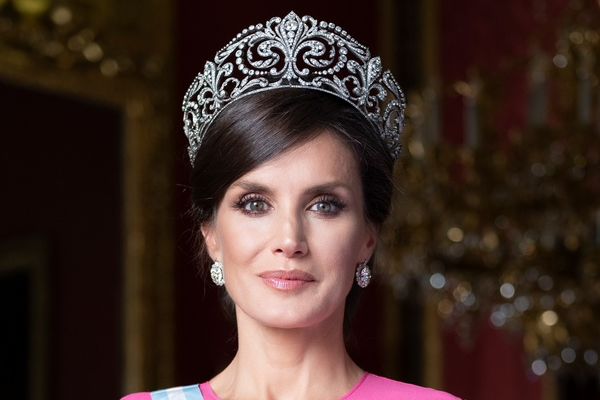 |
| Casa Real |
Today, Spain celebrates its National Day. To join in the commemorations, we’re spending the week delving into one of the most important collections of Spanish royal jewels: the joyas de pasar, which pass from monarch to monarch. Let’s start with the grandest piece from that collection, shall we? Here’s a closer look at Queen Ena’s Fleur-de-Lis Tiara, which many simply call “La Buena.”
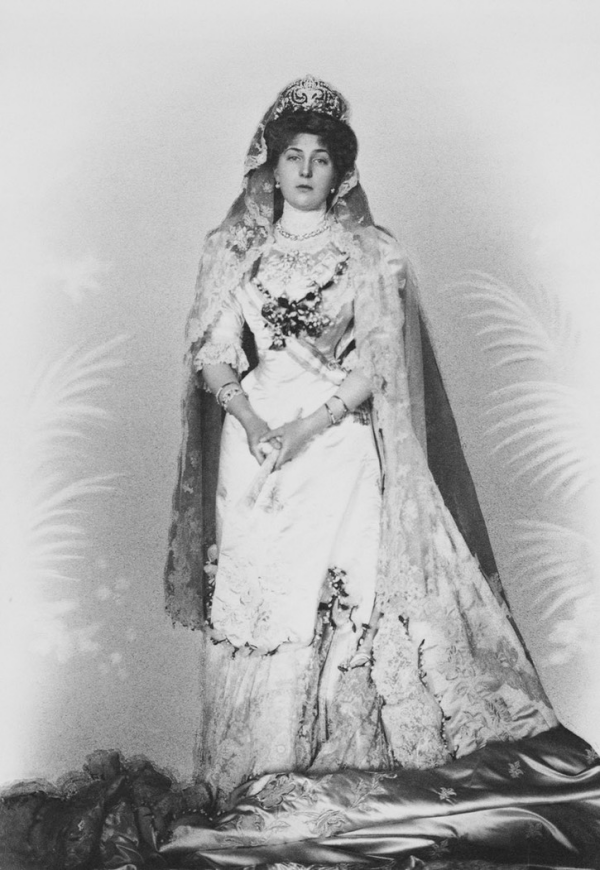 |
| Grand Ladies Site |
La Buena was created in 1906 by Ansorena, court jeweler to the Spanish royal family. The tiara was a wedding gift from King Alfonso XIII to his new bride, Princess Victoria Eugenie of Battenberg (or, as she was generally called, “Ena”), who was a granddaughter of Queen Victoria of the United Kingdom. Above, Queen Ena wears the tiara and her wedding gown in a photographic portrait.
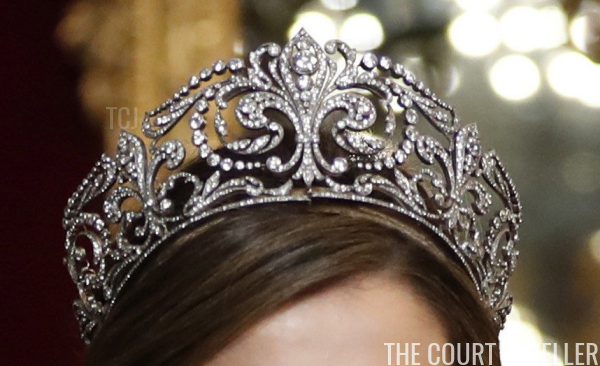 |
| CHEMA MOYA/AFP/Getty Images |
The tiara is enormous, with intricate yet airy diamond-set elements. These are dominated by the large fleur-de-lis designs on the front and sides of the tiara. The fleur-de-lis is, of course, the symbol of the House of Bourbon. Members of this royal dynasty currently sit on the thrones of Spain and Luxembourg, and formerly reigned in France and Italy as well.
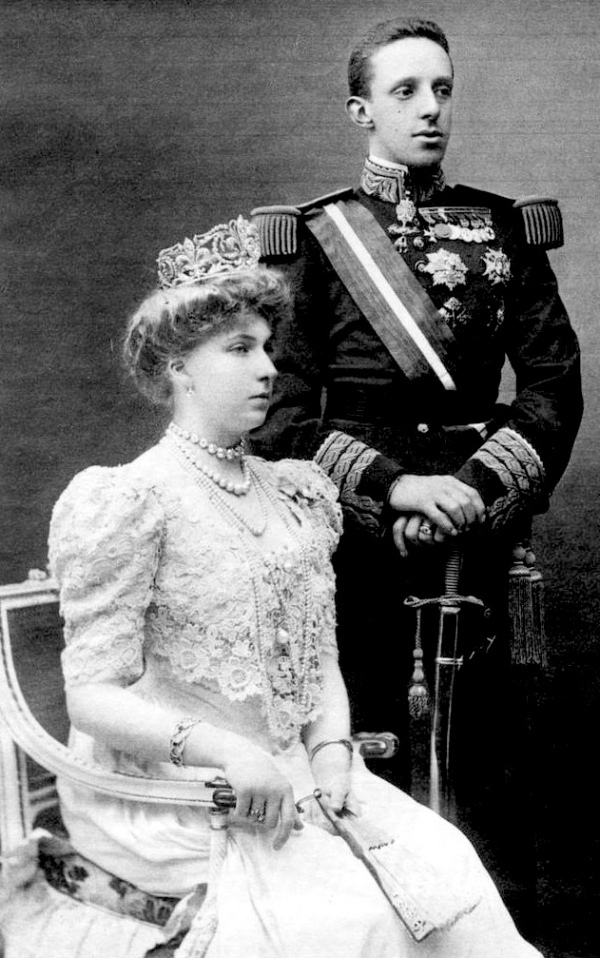 |
| Grand Ladies Site |
Queen Ena wore the tiara for her wedding to King Alfonso, which was held at the Monastery of San Jerónimo el Real in Madrid in May 1906. The wedding itself went smoothly, but the carriage procession afterward ended in tragedy. An anarchist threw a bomb concealed in a bouquet of flowers at the couple’s carriage. Though both Alfonso and Ena somehow managed to escape without physical injuries, twenty-four others were killed and one hundred soldiers and bystanders were wounded. When they arrived at the palace, Queen Ena’s wedding gown was spattered in blood.
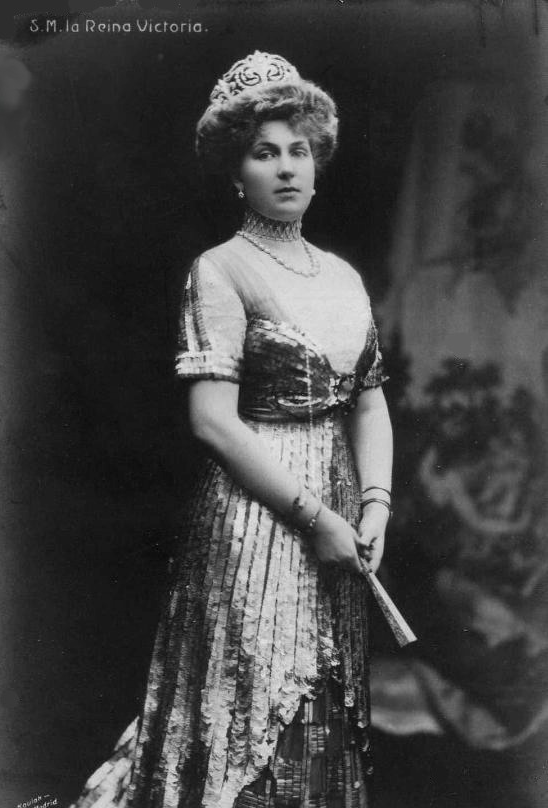 |
| Grand Ladies Site |
Though the tiara had been present for a truly horrific experience, Queen Ena must have rejected any notion that it was somehow tainted by the tragedy. She continued to wear the tiara throughout her husband’s reign. The base of the tiara is flexible, which means that it’s able to be worn in a more closed form, like a coronet, or in a more open setting. In the portrait above, which dates to 1910 and features a stunning Worth gown, Ena wears the tiara in its more open form.
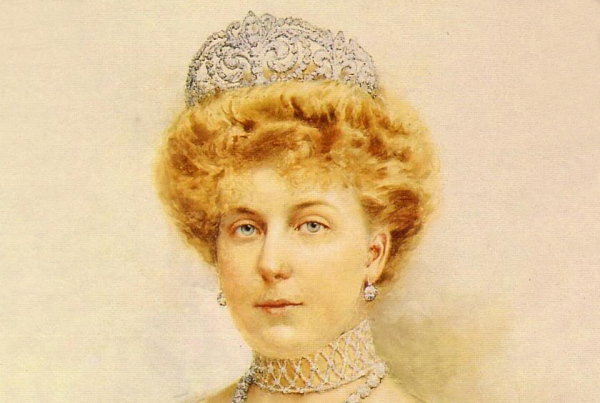 |
| Grand Ladies Site |
In 1914, Queen Ena wore the tiara as she sat for a portrait by Isidro Fernández Fuentes, a Spanish court painter who used the pseudonym “Gamonal.” A detail of the painting is shown above. Today, the full portrait hangs in the Naval Museum in Madrid.
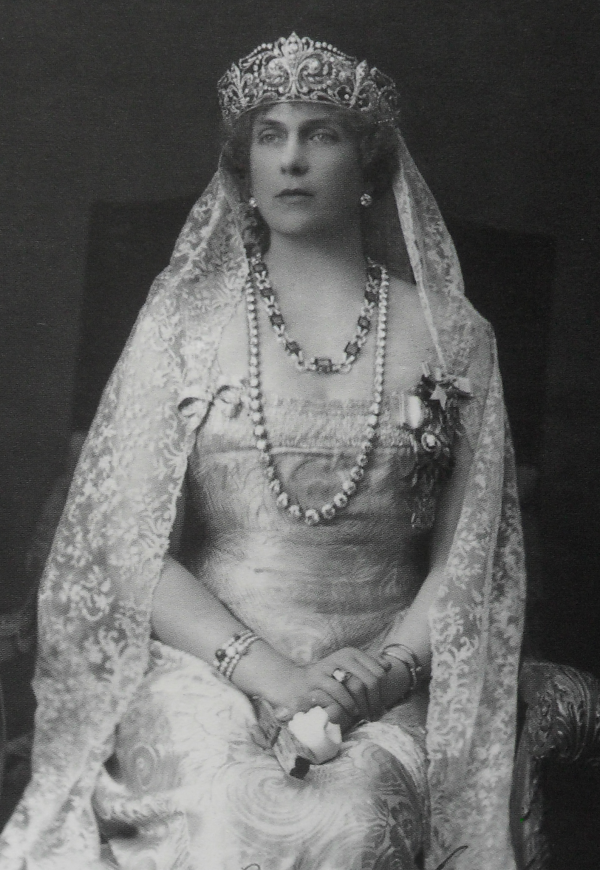 |
| Wikimedia Commons |
By the 1920s, Queen Ena had adopted the tiara-wearing fad of the moment, placing her diadems low across her forehead. This grand photographic portrait from that era also features her emeralds, which came from Empress Eugenie of France. But soon, Ena’s time in Spain would come to an end. She went into exile with the rest of the royal family in 1931, bringing her jewels with her. She continued to wear them throughout the rest of her life in Italy and Switzerland. She also loaned them to her daughter-in-law, the Countess of Barcelona, who wore La Buena at Queen Elizabeth II’s coronation in London in 1953.
In 1963, Queen Ena made a will. The document included a codicil that designated a group of her jewels to be passed down from monarch to monarch — even though Spain didn’t have one at the time. But Ena seems to have been prescient in her decision. After the death of Franco in November 1975, her grandson became King Juan Carlos I. The next wearer of La Buena, accordingly, was his wife, Queen Sofia. She wore the tiara throughout his reign, tending to reserve it for the grandest of gala occasions. Above, in 1988, she wears the tiara for a state banquet in Madrid in honor of Queen Elizabeth II and the Duke of Edinburgh.
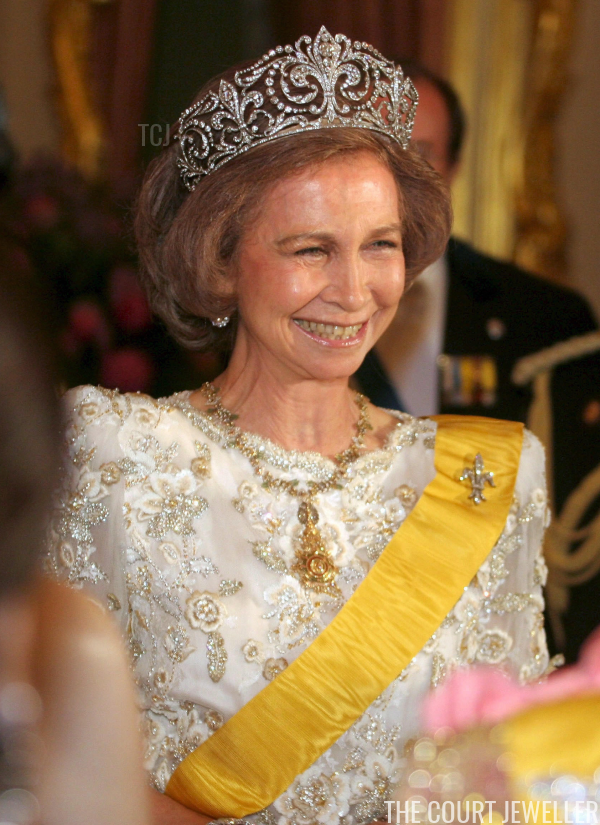 |
| Pool/Getty Images |
In 2006, Queen Sofia packed La Buena in her luggage for a trip to Bangkok, wearing it during the Golden Jubilee celebrations for King Bhumibol Adulyadej of Thailand.
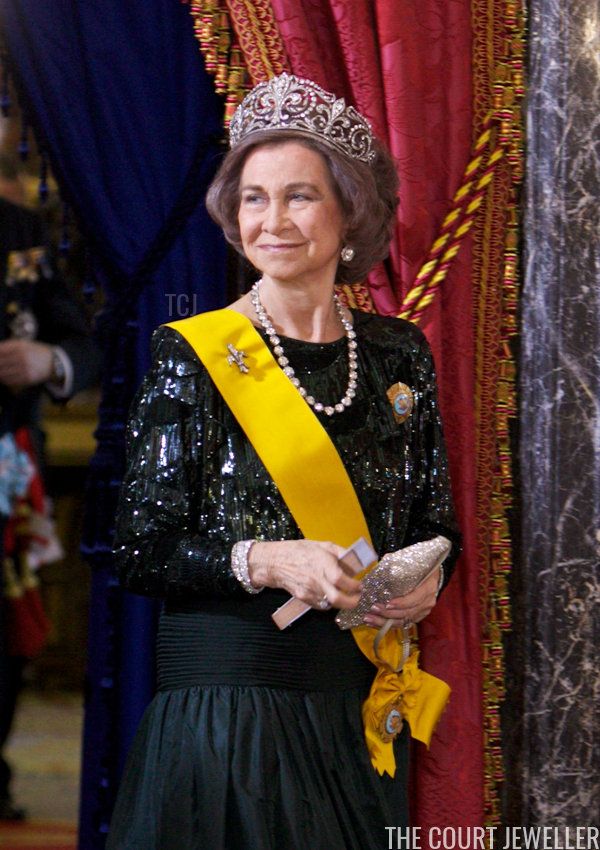 |
| Pool/Getty Images |
In June 2014, Queen Sofia took La Buena out for one last spin. She wore it for a state banquet honoring the President of Mexico — the last such dinner held during her husband’s reign. When he abdicated in favor of their son, King Felipe VI, later that month, the joyas de pasar collection transfered to the new king and his wife, Queen Letizia.
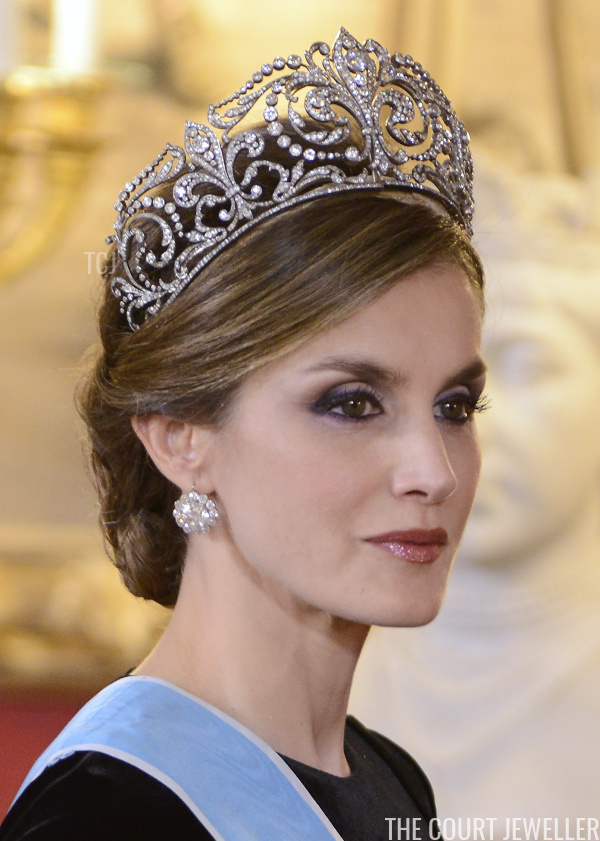 |
| Carlos Alvarez/Getty Images |
Almost three years later, in February 2017, Queen Letizia wore the tiara in public for the first time. The occasion was another state dinner, this time in honor of the President and First Lady of Argentina.
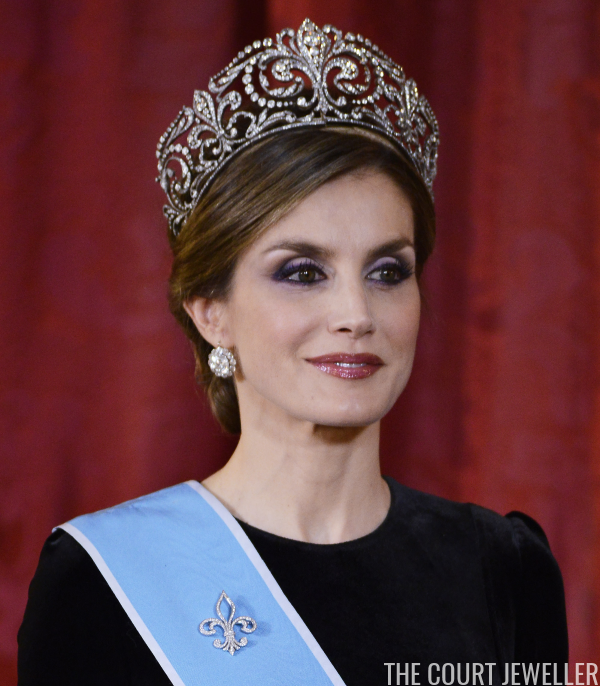 |
| Borja Benito – Pool/Getty Images |
As I noted above, the base of La Buena is flexible, which means that it can be manipulated to fit each individual wearer’s head. When Queen Letizia wore the tiara for the first time, evidence of that type of adjustment was clear, as the thin row of diamonds at the base of the tiara wasn’t properly joined together at the center point.
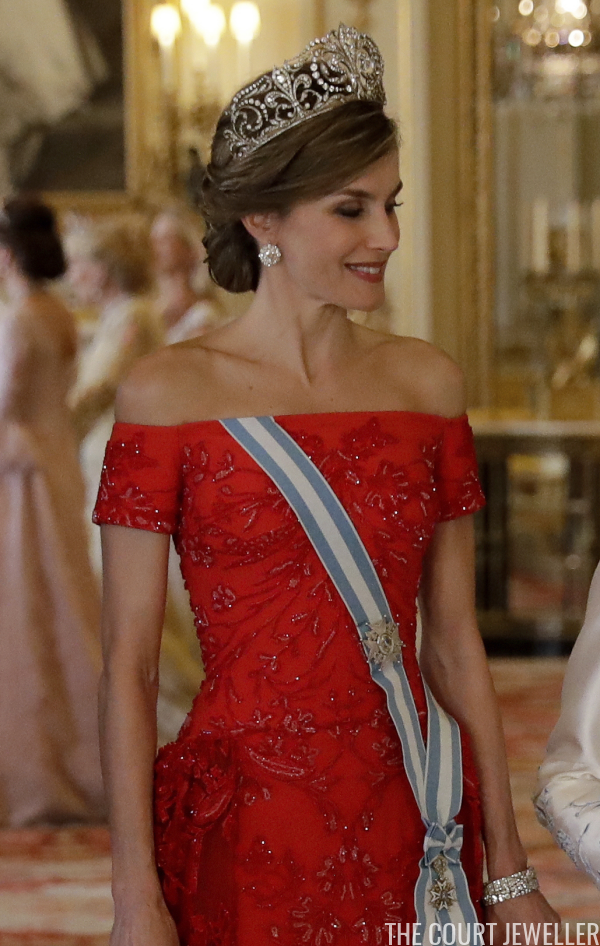 |
| MATT DUNHAM/AFP/Getty Images |
In subsequent appearances, though, the problem with the base has been remedied. Like her mother-in-law, Queen Letizia has generally chosen to wear the tiara for some of the grandest of royal gala occasions. One of these came in July 2017, when she and King Felipe made a state visit to the United Kingdom. Queen Letizia wore the tiara for a state banquet at Buckingham Palace during the visit. The moment was an echo of the past. More than a century earlier, King Alfonso XIII had met Queen Ena for the first time at Buckingham Palace following a dinner during a state visit — an event that ultimately led to the creation of this tiara.
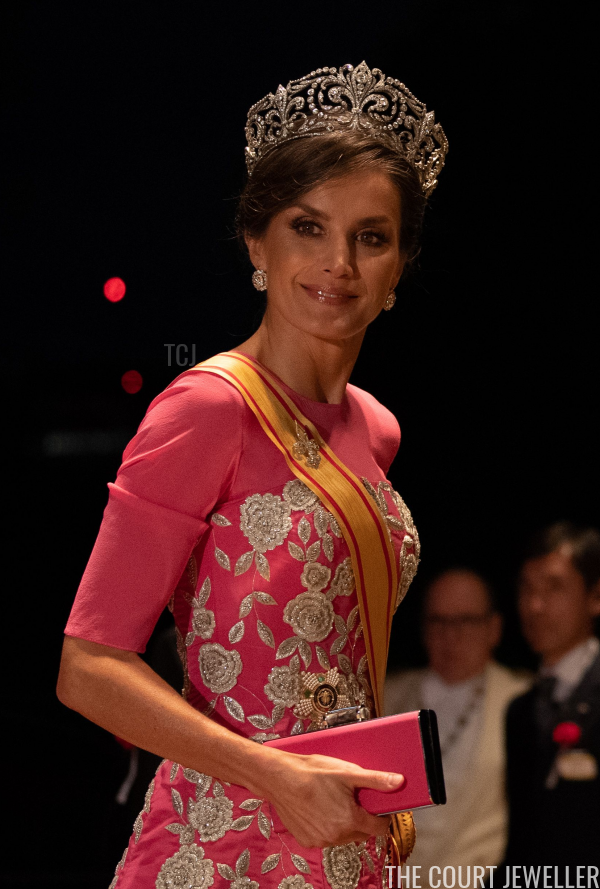 |
| PIERRE EMMANUEL DELETREE/AFP via Getty Images |
One of the most recent appearances of the tiara came in October 2019, when Queen Letizia wore it during the celebrations of the imperial enthronement in Tokyo. She later repeated the complete ensemble for a new set of formal portraits released in February 2020. The Spanish monarchy has ridden a rollercoaster of public opinion and conflict for more than a century. We’ll all have to wait to see whether Queen Ena’s tiara will be worn by the next in line to the throne, the Princess of Asturias.
Leave a Reply